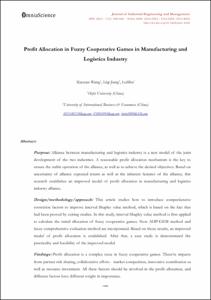Mostra el registre d'ítem simple
Profit allocation in fuzzy cooperative games in manufacturing and logistics industry
| dc.contributor.author | Wang, Xiaoyan |
| dc.contributor.author | Jiang, Liqi |
| dc.contributor.author | Shu, Lei |
| dc.date.accessioned | 2014-05-29T11:11:38Z |
| dc.date.available | 2014-05-29T11:11:38Z |
| dc.date.issued | 2014-05 |
| dc.identifier.citation | Wang, Xiaoyan; Jiang, Liqi; Shu, Lei. Profit allocation in fuzzy cooperative games in manufacturing and logistics industry. "Journal of Industrial Engineering and Management", Maig 2014, vol. 7, núm. 2, p. 448-460. |
| dc.identifier.issn | 2013-0953 |
| dc.identifier.uri | http://hdl.handle.net/2099/14717 |
| dc.description.abstract | Purpose: Alliance between manufacturing and logistics industry is a new model of the joint development of the two industries. A reasonable profit allocation mechanism is the key to ensure the stable operation of the alliance, as well as to achieve the desired objectives. Based on uncertainty of alliance expected return as well as the inherent features of the alliance, this research establishes an improved model of profit allocation in manufacturing and logistics industry alliance. Design/methodology/approach: This article studies how to introduce comprehensive correction factors to improve interval Shapley value method, which is based on the fact that had been proved by exiting studies. In this study, interval Shapley value method is first applied to calculate the initial allocation of fuzzy cooperative games. Next AHP-GEM method and fuzzy comprehensive evaluation method are incorporated. Based on those results, an improved model of profit allocation is established. After that, a case study is demonstrated the practicality and feasibility of the improved model. Findings: Profit allocation is a complex issue in fuzzy cooperative games. There’re impacts from partner risk sharing, collaborative effort market competition, innovative contribution as well as resource investment. All these factors should be involved in the profit allocation, and different factors have different weight in importance. Practical implications: The new model established in the paper is more scientific and reasonable, and more in line with the actual situation. This method also provides good incentives to each enterprise to ensure the healthy and stable development of the alliance. Originality/value: Based on alliance characteristics, this paper establishes an indicator system and a new model for profit allocation in manufacturing and logistics industry alliance, using AHP-GEM method |
| dc.format.extent | 13 p. |
| dc.language.iso | eng |
| dc.publisher | OmniaScience |
| dc.rights | Attribution-NonCommercial 3.0 Spain |
| dc.rights.uri | http://creativecommons.org/licenses/by-nc/3.0/es/ |
| dc.subject | Àrees temàtiques de la UPC::Economia i organització d'empreses::Direcció d'operacions |
| dc.subject.lcsh | Business logistics -- Mathematical models |
| dc.subject.lcsh | Fuzzy sets |
| dc.subject.other | Manufacturing and Logistics Industry |
| dc.subject.other | Fuzzy Cooperative Games |
| dc.subject.other | Improved Interval Shapley Value |
| dc.subject.other | AHP-GEM |
| dc.subject.other | Fuzzy Comprehensive Evaluation Method |
| dc.subject.other | Profit Allocation |
| dc.title | Profit allocation in fuzzy cooperative games in manufacturing and logistics industry |
| dc.type | Article |
| dc.subject.lemac | Logística (Indústria) -- Models matemàtics |
| dc.subject.lemac | Conjunts borrosos |
| dc.identifier.dl | B-28744-2008 |
| dc.description.peerreviewed | Peer Reviewed |
| dc.rights.access | Open Access |
| local.citation.author | Wang, Xiaoyan; Jiang, Liqi; Shu, Lei |
| local.citation.publicationName | Journal of Industrial Engineering and Management |
| local.citation.volume | 7 |
| local.citation.number | 2 |
| local.citation.startingPage | 448 |
| local.citation.endingPage | 460 |
Fitxers d'aquest items
Aquest ítem apareix a les col·leccions següents
-
2014, vol. 7, núm. 2 [15]
Special Issue – LISS 2013


